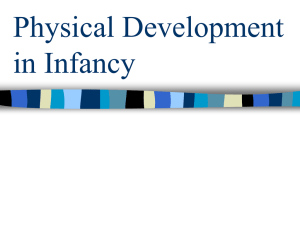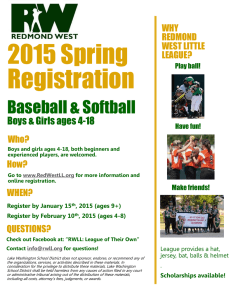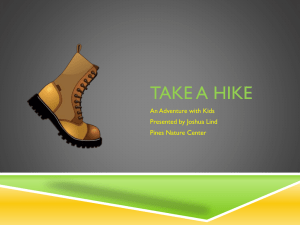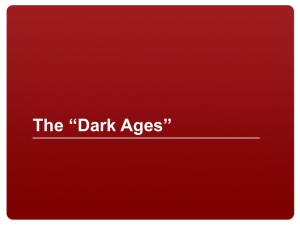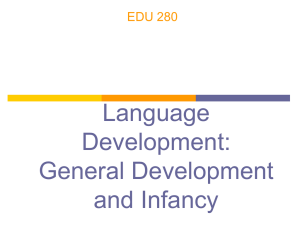INFANCY (0-2 YEARS and reflexes)
advertisement
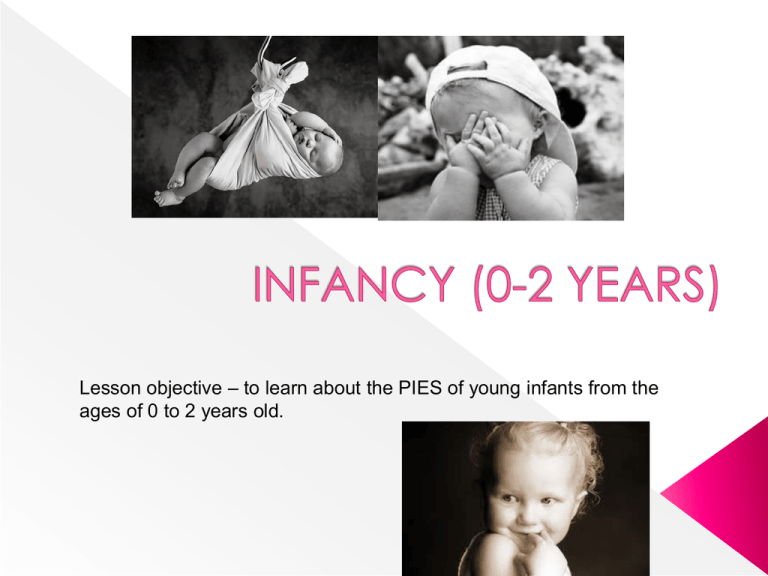
Lesson objective – to learn about the PIES of young infants from the ages of 0 to 2 years old. Babies develop very rapidly during the first three years of life. They are born with a number of physical reflexes. A reflex is an uncontrolled response to a physical change (E.G MOVING YOUR HAND AWAY FROM A HOT PLATE). Lesson objective – to learn about the PIES of young infants from the ages of 0 to 2 years old. THE BABY TURNS IT’S HEAD IN THE DIRECTION OF THE TOUCH, ENABLING IT TO FIND THE NIPPLE OF IT’S MOTHER’S BREAST TO OBTAIN FOOD. http://www.youtube.com/watch?v=XMUrKQjDL-g Lesson objective – to learn about the PIES of young infants from the ages of 0 to 2 years old. When startled, a baby throws out is arms and legs, then pulls them back with fingers curved. Lesson objective – to learn about the PIES of young infants from the ages of 0 to 2 years old. A BABY WILL GRASP AN OBJECT PLACED IN THE HAND. http://www.youtube.com/watch?v=jzKufhWZ2Yw&NR=1 Lesson objective – to learn about the PIES of young infants from the ages of 0 to 2 years old. http://www.youtube.com/watch?v=gyVLD0 hl0XY WHEN A BABY IS HELD WITH IT’S FEET TOUCHING THE GROUND ITS LEGS WILL MAKE FORWARD MOVEMENTS, AS IF WALKING. Most parents are surprised by this reflex. If you hold your baby under his arms, support his head, and allow his feet to touch a flat surface, he will appear to take steps and walk. This reflex usually disappears by 2-3 months, until it reappears as he learns to walk at around 10-15 months. Lesson objective – to learn about the PIES of young infants from the ages of 0 to 2 years old. Match the correct reflex to the correct description. WALKING REFLEX GRASP REFLEX MORO REFLEX ROOTING REFLEX Lesson objective – to learn about the PIES of young infants from the ages of 0 to 2 years old. Fine Motor Skill Development This is the child's ability to use small muscles, specifically their hands and fingers, to pick up small objects, hold a spoon, turn pages in a book, or use a crayon to draw. Gross Motor Skill Development This is the child's ability to use large muscles. For example, a six-month-old baby learns how to sit up with some support, a 12-month-old baby learns to pull up to a stand holding onto furniture, and a five-year-old learns to skip What is a developmental milestone? A developmental milestone is a skill that a child acquires within a specific time frame. For instance, one developmental milestone is learning to walk. Most children learn this skill or developmental milestone between the ages of 9 and 15 months. During the first two years babies learn to control their muscles and movements. The control of large muscles, such as in the arms and legs, is called GROSS MOTOR SKILLS. The control of smaller muscles and movements, such as those in the fingers, is called FINE MOTOR SKILLS. Lesson objective – to learn about the PIES of young infants from the ages of 0 to 2 years old. 0-6 months Gross Motor Skills: ● lift head ● kick their legs ● roll over ● sit with support ● begin to crawl ● likes to bounce with support 6-12 months Gross Motor Skills: ● sit unassisted ● pull to standing position ● walk holding onto furniture ● move from lying to sitting position ● crawls well Q1) What are reflexes?. Q2) Describe the reflexes of a new born baby. Q3) Describe and give 3 examples of a fine motor skill. Q4) Describe and give three examples of a gross motor skill. Q5) What is parallel play?. Q6) What is cooperative play?. Lesson objective – to learn about the PIES of young infants from the ages of 0 to 2 years old. What is a developmental milestone? What is a developmental milestone? A developmental milestone is a skill that a child acquires within a specific time frame. For instance, one developmental milestone is learning to walk. Most children learn this skill or developmental milestone between the ages of 9 and 15 months. AGE GROSS/ FINE MOTOR SKILL?? NEW BORN PRIMITIVE REFLEXES 1 MONTH LIFTS UP CHIN, SOME CONTROL OF HEAD. 6 MONTHS CAN MOVE OBJECTS FROM ONE HAND TO ANOTHER. PICKS UP DROPPED TOYS IF THEY ARE IN SIGHT. 15 MONTHS CAN WALK WITH OUT HELP 2 YEARS OLD KICKS A BALL. 2/3 YEARS OLS CAN BUILD A TOWER OF BRICKS. 2/3 YEARS OLD STANDS ON TOES, CAN RIDE A TRICYCLE. AGE GROSS MOTOR SKILL NEW BORN PRIMITIVE REFLEXES 1 MONTH LIFTS UP CHIN, SOME CONTROL OF HEAD. 6 MONTHS CAN MOVE OBJECTS FROM ONE HAND TO ANOTHER. PICKS UP DROPPED TOYS IF THEY ARE IN SIGHT. 15 MONTHS CAN WALK WITH OUT HELP 2 YEARS OLD KICKS A BALL. 2/3 YEARS OLS 2/3 YEARS OLD FINE MOTOR SKILL CAN BUILD A TOWER OF BRICKS. STANDS ON TOES, CAN RIDE A TRICYCLE. The most important intellectual development an infant makes is the ability to use and understand language. Babies understand simple words such as ‘bye-bye’ at 6-9 months. At two years old, most children will start using two word statements ‘ZOE SLEEP’. Intellectual development is helped by play. Children can look at books to help stimulate them and increase their ability to recognise objects. SOLITARY PLAY Normally occurs during infancy, infants will play by themselves. Lesson objective – to learn about the PIES of young infants from the ages of 0 to 2 years old. PARALLEL PLAY Is when chidlren play next to each other, but not together. For example, one child may play with building blocks and another with a doll. Lesson objective – to learn about the PIES of young infants from the ages of 0 to 2 years old. CO-OPERATIVE PLAY IS WHEN CHIDLREN PLAY TOGETHER, FOR EXAMPLE A GAME OF TAG. Lesson objective – to learn about the PIES of young infants from the ages of 0 to 2 years old. PRETEND PLAY A TYPE OF PLAY THAT ALLOWS CHILDREN TO LEARN ABOUT THEIR WORLD. FOR EXAMPLE, PLAYING HOUSE. Lesson objective – to learn about the PIES of young infants from the ages of 0 to 2 years old. Occurs satisfactorily if a secure attachment/ relationship has been made in the first years of life. As the child gets a little older, he or she will begin to be interested in other children. By the age of two her or she will play alone with other children, this is called PARALLEL PLAY. A child is about 4 before he or she can play properly with another child. This is called CO-OPERATIVE PLAY. Lesson objective – to learn about the PIES of young infants from the ages of 0 to 2 years old. During the first 18 months of life, infants develop an emotional bond with their carers. This boding process ties the infant emotionally to familiar carers. USE THE INTERNET AND RESEARCH THE WORK OF JEAN PIAGET AND BANDURA. PRESENT YOUR FINDINGS IN A WRITTEN REPORT. You must make sure you include the following: name of theorist, outline of work, any key terms. Socially, young children and particularly infants tend to focus on the adults who are close to them and become bonded to a small group of people early in life - mainly the people who care for them. This forms the basis for attachment which is the strong emotional tie felt between the infant and significant other. The quality of attachments depends upon the adults. When attachments are formed, young infants learn that they can depend on mothers, fathers, caregivers, or older siblings to make them feel better. Attachment begins early in life and infants show several early attachment behaviors. Behaviors such as cooing, kicking, gurgling, smiling and laughing show that infants care for and respond early to people who are important to them. Crying and clinging are also attachment behaviors of infants which are used to signal others. Infants as early as one month old show signs of attachment in the form of anxiety if they are cared for by an unfamiliar person. They may show distress signs such as irregular sleeping or eating patterns. Lesson objective – to learn about the PIES of young infants from the ages of 0 to 2 years old. Is another attachment behaviour of infants. This is when a child shows distress by often crying when unhappy because a familiar caregiver (parent or other caregiver) is leaving. The first signs of separation anxiety appear at about six months of age and are more clearly seen by nine months of age. Separation anxiety is very strong by 15 months of age and begins to gradually weaken around this time also. Parents and other caregivers need to understand and prepare for this attachment behavior (separation anxiety) in children by making transitions easier for the child. Children between the age of 9 and 18 months will usually have a lot of difficulty beginning a child care program. Parents can make the transition easier by bringing the child's favorite toy or blanket along. It is also important to understand separation anxiety as a normal developmental process in which children are fearful because their familiar caregivers are leaving them. Children beginning a child care program are in an unfamiliar surrounding with unfamiliar people. Children will gradually show less distress as the setting, the people, and routines become more familiar to them. Lesson objective – to learn about the PIES of young infants from the ages of 0 to 2 years old. http://www.youtube.com/watch?v=_JmA2ClUvUY Lesson objective – to learn about the PIES of young infants from the ages of 0 to 2 years old. Lesson objective – to learn about the PIES of young infants from the ages of 0 to 2 years old. begin to self soothe after crying be able to express various emotions eg. anger, sadness, happiness be developing a sense of love and trust with caregiver(s) be very curious about their environment start to have mood swings and temper tantrums object when they cannot not have their own way loving but tend to be self centered in their view of the world show separation anxiety when caregiver leaves Lesson objective – to learn about the PIES of young infants from the ages of 0 to 2 years old. Tips to Nurture Babies’ Social and Emotional Development Hold babies while feeding. Even if the baby holds the bottle, being held and cuddled during feeding helps develop a strong nurturing relationship with the child care provider. Never prop a bottle in a baby’s mouth; it may cause choking. Respond every time a baby cries. Crying is the only way young babies can tell you what they need. Help babies learn to trust you by picking them up, talking to them and taking care of their basic needs. Be consistent so your baby knows what to expect. You cannot spoil a baby by responding to her cries. Stay close to babies when someone new is around. As babies get older, they are wary of strangers. This is sign of a strong, positive attachment. Encourage strangers to approach babies slowly. Introduce the babies to the new person. Give them a chance to become familiar with the new person in the safety of your presence before that person picks them up. Help families handle separation anxiety. Around 8 to 12 months, many babies cry when parents drop them off at child care. Help parents understand that this means their baby has a strong bond with them. Be sure parents say goodbye before they leave their child. Provide gentle reassurance when babies cry. Talk about babies’ families, and reassure them that the parent will be back later. Stay with the same group of infants as long as possible. Babies need a consistent, reliable child care provider to build a strong attachment. Avoid moving babies from room to room or teacher to teacher. Lesson objective – to learn about the PIES of young infants from the ages of 0 to 2 years old. GCSE Y10 – Newborns - Reflexes
